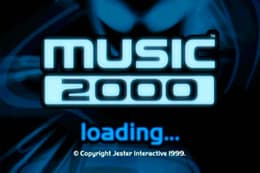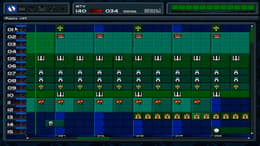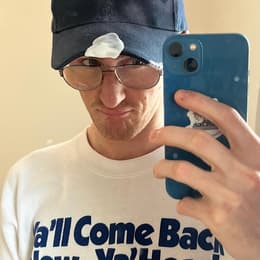Music 2000 - a game released 26 years ago on the PlayStation 1 - gave its players access to a professional recording studio, something utilised by everyone from Skepta to Hudson Mohawke. Nathan Evans explores how this game upcycled the PS1, planting the seeds for the influential grime scene in the UK.
The default image of a music studio was once of a sprawling mixing desk in its own amber-glowing, veneer-dominated room. However, back in 1999, a PlayStation 1 game gave thousands of gamers the chance to control an entire music studio from the comfort of their humble bean bag chairs.
Released 26 years ago, Music 2000 transformed music production for the better, allowing some to use a video game format to plant the seeds for their own vibrant artistic careers. This game’s indelible impact on 21st Century British music is reflected by the platform it gave to legendary grime producers – from Skepta, JME, and Dizzee Rascal.
Other prominent musicians - including Hudson Mohawke, Bob Vylan, and Kode9 - kick-started their musical journeys through holding a DualShock controller and starting out at the bouncing drum kit on Music 2000’s loading screen.
From PlayStation to music studio
Known as MTV Music Generator in North America, Music 2000 was developed by Jester Interactive. This was a small team led by Tim Wright, the video game music composer who worked under the name CoLD SToRAGE. In the late 90s, he attained respect for his ground-breaking, techno and trance-inspired compositional work for the PlayStation 1 sci-fi racing game Wipeout. It was the first major gaming title inspired tonally by rave culture.
Wright casts his mind back to the original impetus for his follow-up game. “I remember being a teenager in North Wales, completely obsessed with making music, but any kind of professional-level equipment was beyond my financial reach,” he says. “There was one guy in town who owned a four-track cassette recorder. I’d beg him endlessly to let me use it; on the rare occasions he’d oblige, I felt like I was touching gold. I kept remembering those days and thought, ‘If so many teenagers already have a PlayStation in their living room, what if that box could become their music studio?’”

Music 2000 was developed by Jester Interactive
Enter Music 2000. While the PS1 gave home to a handful of music-making games - such as the more experimental Dolphin-based sound lab Fluid and even rhythm-based games like PaRappa the Rapper - none had presented a fully-fledged music studio that allowed players to construct a multi-part song and even manipulate individual notes. By being on the Sony console, Music 2000 was also available to a huge audience beyond professional and amateur musicians, and it engaged young people by feeding music production through the language of video games.
“The uniqueness [of Music 2000] came from the mindset of play-meets-creation,” Wright says. “The interface had to be approachable – you load a riff, you play with it, you drag loops around, you build your song. But under the hood there are advanced controls – envelopes, effects, precise note adjustments, re-triggering, sample offsets etc. So people can start simple and gradually dive deeper. It’s like, ‘here’s the playground, now here’s the workshop if you want it.’”
It helped that the technical wizardry Jester pulled off on the PS1 was nothing short of miraculous. On a console with 512KB of RAM and 24 audio channels, the game allowed players to use every last morsel of the console’s processing power. Each of its 24 channels came with an individual editing capability for each note, as well as volume, reverb, tempo and key data, allowing the user to change the quality as the song goes on. Songs could extend to up to 999 bars, and users had access to 3000 eclectic samples on disc, a video programmer, and a sampler that could record any audio output from the PlayStation (even audio CDs and other games).
With Wright’s astute knowledge of 90s club sounds, the samples were impressive, not just in their breadth but also their authenticity. He introduced young people to the sounds of trance, dub techno, breakbeat, house and more. “When I worked on Wipeout, I was swept up in the UK big-beat, electronica, club culture of the mid-’90s,” Wright recollects. “With Music 2000, I wanted users to feel like they were making real club tracks, not cheap keyboard toy-town stuff. The sonic palette for samples was both personal and strategic.”
Toy In Da Corner: the game’s impact on grime
Around the time of Music 2000’s release, London artist and anointed “Godfather of Grime” Wiley had already made “Eskimo,” a garish, acidic retooling of UK garage that would come to be known as arguably the first ever grime beat. The genre of grime would then begin its 20-year ascent to the creative pinnacle of Black British music, fueled by a willingness to create and distribute music outside of industry norms, while also using whatever tools artists had at their disposal.
Hackney-born Smasher, a producer for legendary UK rappers including Giggs, Ghetts and Devlin, was 13 when he first spun decks on pirate radio. Music 2000 became his introduction to programming beats on a screen during his late teens. “I was living in a pub in East London, literally a stone's throw from where Wiley and Dizzee and the whole of the grime scene emerged from,” he remembers, speaking to Back Market from his recording studio. “I used to drive past Dizzee Rascal standing outside the sweet shop, and I'd be listening to the radio hearing the beats that were being made.”
Smasher joined the likes of Skepta, Dark0 and Terror Danjah in getting their start on Music 2000, which means there’s a direct link between grime and this cult PS1 game. This also speaks to how Music 2000 introduced the idea of music production software directly to working-class youths who otherwise would have been priced out of making music. “I definitely would not have been able to afford a [professional setup]. To have a studio back then, you would literally have to know someone that could custom-build you a PC,” Smasher says. “Music 2000 was something that was accessible, it was something I could actually get my hands on. ”
Wright became aware of grime producers using Music 2000 perhaps before anyone else. “I started receiving messages and hearing tracks from underground producers who said they cut their teeth on Music 2000 and other versions of the product,” he says. “It really blossomed a few years post-release when the second-hand market exploded and producers were using everything they could to create loops and beats.”
In the hands of all these young people, the game was stretched beyond its already immense capabilities and some even pressed their Music 2000 beats onto vinyl dubplates. “I've got acetates of my early productions that I've made on Music 2000,” Smasher explains, raising £500 worth of acetate vinyl in his grasp. “You had the audio output - the red and white [cables] - at the back of the SCART lead, then a Phono output. It used to come out of the PlayStation into a MiniDisc player, and I would record it onto the MiniDisc and go to Music House, which was a cutting house where you could go and pay to get your one track cut to a 10-inch dub. To me this was a way to have an exclusive that someone else didn't have.”
This practice became so commonplace that many of grime’s most important tracks – Youngstar’s “Pulse X”, Benga’s “Skank”, Dizzee Rascal’s “Stand Up Tall” - were all rumoured to have been made on Music 2000. Skepta’s first ever track, “Pulse Eskimo”, is 100% confirmed to be ripped straight from the game. In a 2023 Mixmag interview, Skepta referenced Music 2000 directly, saying: “Me and my brothers, we’ve always been gamers. That’s why I really love producing [...], because it's literally a game.”

"It was kind of like Tetris in the way you could program beats.” - Smasher, Grime Producer and Artist
For Smasher, the game had similarities with another influential game that broke boundaries. “In Music 2000 you could pick a block of beats and place it in to program a little melody or something,” Smasher explains. “It was kind of like Tetris in the way you could program beats.” And with Wright’s library of samples, Music 2000 helped to define the sound of grime, using its sound packs to create the urgent, digitised beats grime came to be known for.
Its sampler function meant removing the game disc altogether, but when another audio CD was inserted, players could rip samples from this CD on the fly, making them part of a song by saving them on the PS1’s memory card. Naturally, this led to producers sampling the other video games they had on the system. You want to make a rap beat out of Metal Gear Solid samples? Go ahead.
Still striving: Music 2000’s impact then and beyond
The Music series would go on to sell 1m copies, but it ended altogether in 2004. However, the 2000 entry still has an active community of producers today, spawning a genre of itself on Bandcamp featuring players creating new beats from its samples. And, with grime’s history so well-documented, international producers like Disctr4k and Introspekt have gone back and used the game’s samples to create contemporary music.
“I really appreciate all the aspects of that game,” says Buffalo, New York producer Disctr4k (real name Doxa Murego), who began using the game at 13 and knew it first as Music 2000 despite growing up in the US, where it was known as MTV Music Generator. “All the chords and the melodies, the drum hits and how you're able to write melodies and even sample. It felt like a fully-fledged DAW. ”
Before coming into contact with the software, Disctr4k was creating novelty beats through sampling music from various Nintendo Wii games. But once he played around with Music 2000’s sounds, he moved towards the inventive, future-forward take on classic house and jungle he creates today. “It definitely pushed me towards finding my sound,” he says.
Disctr4k was born after the release of the Playstation 3, so why go all the way back to the Playstation 1 for music production software? He describes the game as, “very outgoing and joyful”, and it’s clear he experiences anemoia - nostalgia for a time he never knew. “I definitely wish I grew up in a generation that got to actually use Music 2000 on their PlayStation. I'd hear people would sit on their bean bags and just make tracks after a night out. And I just thought, ‘wow, that is just sick’”.
Creating music with next-gen consoles
In the modern games market, titles such as Music 2000 have largely disappeared. “The gaming business has changed,” Wright offers as an explanation. “Budgets have risen, but only for mainstream games, while ROI expectations have grown, free-to-play mechanics have spread, and the idea of a music creation console app is harder to sell into traditional retail.” This means it’s unlikely to see any next-gen Music 2000 remakes any time soon.
But, from another angle, the spirit of Music 2000 lives on in more portable devices. Wright’s description of his creation as a “console app” shows how far ahead he was in his thinking, as over time, smartphone and tablet apps have replaced game consoles as the medium for upcycled music making. GarageBand for iOS has allowed artists like Steve Lacy to break through with an EP made completely on his iPhone, and in the Global South, Brazilian baile funk producers are creating careers from tracks made on phones, iPads and video editing software.
Music 2000 was the first sign of the possibility for upcycling a gaming console for music production, showing that video games could truly be used to create, not just to consume. “It felt like magic,” Smasher concludes. “With Music 2000 I could walk into this room today with nothing, but I would still leave here with something.”


